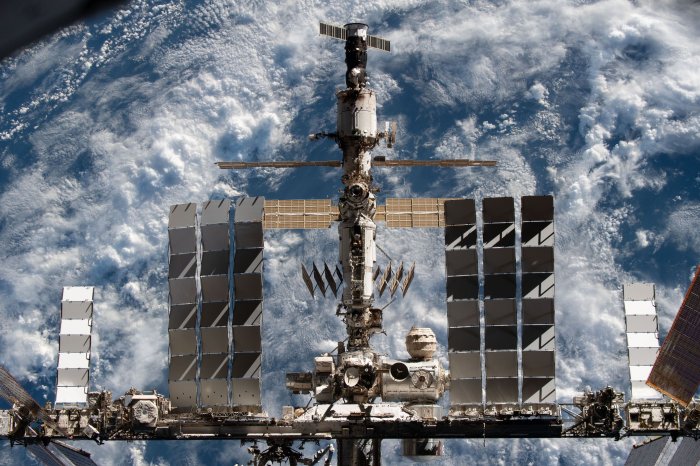1 of 2 | An illustration depicts a spacecraft propelled by solar electric thrusters. Image courtesy of NASA
ORLANDO, Fla., June 14 (UPI) -- NASA and the space industry will conduct several missions over the next year to test more efficient, environmentally friendly spacecraft, including a non-toxic propellant and solar power.
The rapid expansion of private spaceflight, along with planned missions to the moon and Mars, has prompted a need for easier handling of spacecraft and their fuel, Jeff Sheehy, NASA's chief engineer for space technology, said in an interview.
The industry traditionally relied on dangerous chemicals such as hydrazine, which has toxic fumes, or liquefied oxygen, which has to be supercooled and is highly explosive. But new fuels without such risks have lower handling costs and improved safety, Sheehy said.
"Everybody wants to build their own small satellite these days, but there are few places in the country where you can handle toxic hydrazine," he said.
"On the other hand, anybody can store and handle the green propellant that we've used, and so that opens up the whole field really to a much wider range of potential users."
NASA tested a new fume-free fuel known as ASCENT -- Advanced Spacecraft Energetic Non-toxic Propellant -- in 2019 on an experimental satellite, the GPIM. The experiment was a success, allowing the small spacecraft to maneuver as a hydrazine-fueled craft would.
NASA plans to use the same cleaner fuel in a tiny craft that will be sent to the moon on the scheduled Artemis I mission called the Lunar Flashlight later this year. The mission would be one of several to hunt for water ice on the moon.
"Lunar Flashlight will broaden the demonstrated applicability of the fuel," Sheehy said.
Another green fuel experiment just concluded successfully in space using only water for fuel, he said. That was an experimental craft called Hydros by Seattle-area company Tethers Unlimited, which was launched on a SpaceX rocket from Florida in January.
The spacecraft employed electrolysis to split water molecules into hydrogen and oxygen and used those elements for fuel. The company considers the experiment a success, Rob Hoyt, the president and CEO, said in an interview.
"There's a market for Hydros for certain types of missions, and it can be scaled to handle various sizes of spacecraft," Hoyt said.
While the Air Force Research Laboratory developed the non-toxic ASCENT fuel, rocket engine maker Aerojet Rocketdyne builds engines that use it.
The Sacramento-based company also makes a line of smaller engines that use the new propellant and small amounts of hydrazine, Joe Cassady, executive director of space, said in an interview.
"ASCENT actually gets better performance in small spacecraft than hydrazine does. And that's been sort of a serendipitous finding that we learned during testing and demonstration," Cassady said.
Despite better performance, the non-toxic fuel burned much hotter than hydrazine, which required more expensive, heat-resistant materials in the GPIM engine, Cassady said.
Because of that expense, Aerojet Rocketdyne has developed new fuels that are less toxic than pure hydrazine, but burn slightly cooler and allow construction of less expensive engines, he said. Eventually, Cassady hopes the company can deliver fueled spacecraft engines through standard shipping.
Such fuels are ideal for small or even tiny satellites, known as CubeSats, that are being launched into space in growing numbers to conduct experiments, Cassady said.
Solar electric thrusters also offer an alternative to toxic fuels, according to NASA.
NASA recently awarded a new $124,000 contract to Colorado-based ExoTerra Resource to develop an upper stage for a rocket mission that would use solar panels to charge electronic thrusters. Eventually, NASA wants to expand the use of such thrusters to deep space missions, according to the contract announcement.
"ExoTerra is excited to ... enable micro-satellites and micro-landers to reach ... the moon and interplanetary destinations from responsive small launch vehicles," ExoTerra's CEO Michael VanWoerkom said in a news release.
Solar sails, meanwhile, can move small, relatively inexpensive spacecraft by catching solar winds with the use of large mirrors, according to NASA.
Japan, NASA and the California-based non-profit Planetary Society have tested solar sails in 2010, 2011 and again in 2019.
NASA plans a much bigger solar sail test in 2025, the Solar Cruiser, which will spread out to 17,800 square feet -- about the size of six tennis courts. Solar Cruiser would orbit the sun and be used to detect solar flares, according to NASA's mission description.
"NASA and other organizations continue to pursue the development and demonstration of solar sails, which use the momentum from solar photons for propulsion," Sheehy said.
The International Space Station is pictured from the SpaceX Crew Dragon Endeavour during a flyaround of the orbiting lab that took place following its undocking from the Harmony module’s space-facing port on November 8. Photo courtesy of NASA
















